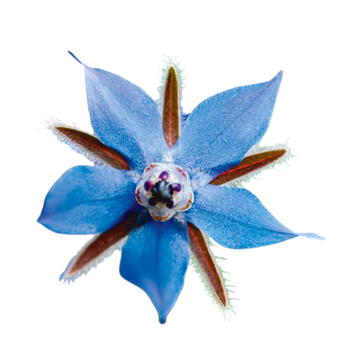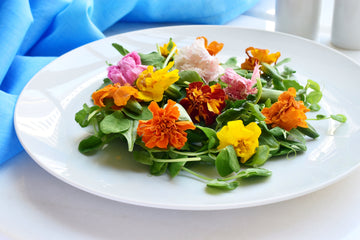Borage

Freshly Harvested

Non-GMO & Natural

Nutrient Dense

Trusted by Chefs
25 Seeds+
🌸 Borage Flower Seeds
Borago officinalis
Known as the “starflower” ⭐🌿, Borage is a Mediterranean heirloom celebrated for its stunning sapphire-blue blossoms 💙 and refreshing cucumber flavor 🥒. Fast-growing and generous, this annual fills the garden with color, nectar-rich blooms, and natural pollinator magnetism 🐝🦋. Easy to grow, self-seeding, and endlessly useful in the kitchen — a true gardener’s and chef’s delight.
👅 Flavor Profile:
Crisp cucumber 🥒, mild herbal 🌿, with a gentle floral finish 🌸.
🍴 Culinary Uses:
🥗 Fresh edible garnish for salads, cheese boards, and summer plates
🍸 Float blooms in cocktails or freeze in ice cubes for stunning drinks
🍲 Infuse into soups or broths for a subtle cucumber-herbal note
🍵 Leaves can be steeped as a calming herbal tea
🍓 Companion to fruits like strawberries and citrus for bright contrasts
👨🍳 Chef’s Pitch:
Borage is the chef’s secret floral garnish 🌸👨🍳. Its star-shaped blossoms add elegance to cocktails, desserts, and composed plates, while the cucumber-like flavor surprises and refreshes. A favorite in fine dining for its beauty, versatility, and ability to spark conversation at the table.
🌱 Growing Notes:
🪴 Vigorous annual reaching 18–36” tall, branching and bushy
🌼 Star-shaped flowers open blue 💙 and sometimes blush pink 💕 before fading
🐝 Heavy pollinator attractor — bees can’t resist
🔄 Self-seeds readily, providing blooms year after year
⏱ Quick to flower, producing continuously through summer
✨ Quick Facts:
-
Latin Name: Borago officinalis
-
Habit: Annual, 18–36” tall
-
Flavor: Cucumber-like with floral notes
-
Culinary Uses: Garnishes, cocktails, salads, teas, infusions
-
Companion Planting: Boosts pollination, pairs well with strawberries 🍓 & tomatoes 🍅

Borage

Let’s Manifest Beauty.
Edible Flowers that Smile.
Edible flowers are more than just decoration — they’re a chef’s secret for adding elegance, fragrance, and subtle flavor to a dish. From citrusy marigolds to honey-sweet alyssum and tangy begonias, these delicate blooms transform plates into experiences. Each petal offers color, aroma, and taste, turning simple ingredients into a culinary statement.

Flowers are here to stay
The Art of Garnishing with Edible Flowers
A garnish should do more than decorate — it should enhance. Edible flowers bring color, fragrance, and subtle flavor to the plate, turning simple dishes into memorable experiences. From delicate petals scattered across a salad to a single bloom crowning a dessert, flowers add elegance and elevate presentation in ways that engage every sense.
The Secret Ingredient Chefs Trust
Widely used in professional kitchens, microgreens enhance flavor profiles while adding nutrition and a striking visual appeal to everything from sandwiches to fine dining creations.
Frequent Asked Questions
Q: What are Microgreens?
Microgreens are young, tender plants harvested just after the first leaves develop. They’re packed with flavor, color, and nutrients, making them both delicious and healthy.
Q: Are microgreens really more nutritious than regular vegetables?
Yes. Research shows that microgreens can contain up to 40x more vitamins and antioxidants (like A, C, K, and E) compared to their mature counterparts.
Q: How do I use microgreens in my meals?
They’re incredibly versatile—use them as a garnish, in salads, on sandwiches, in wraps, smoothies, soups, or even as a centerpiece ingredient in gourmet dishes.
Q: How long do microgreens stay fresh?
Stored properly in a fridge, microgreens typically last 5–7 days. To keep them at peak freshness, store them dry in a breathable container.











